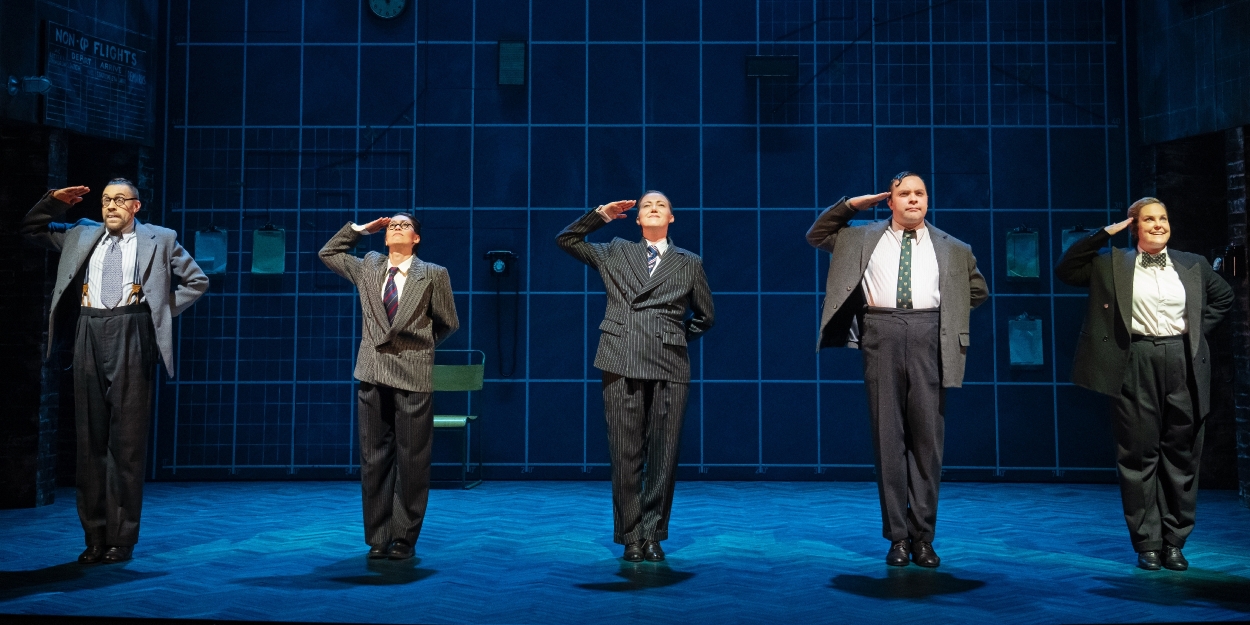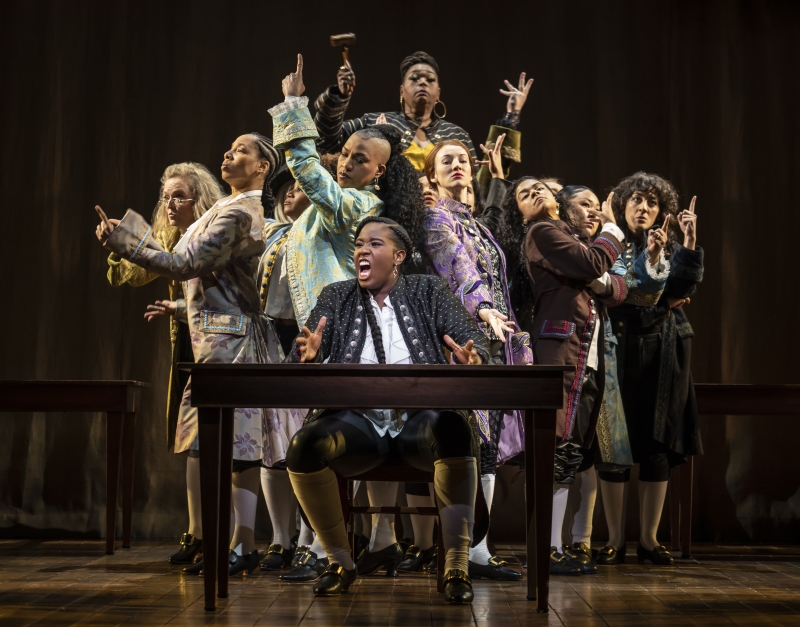How Often Do Broadway Musicals Tackle the Topic of War?
Operation Mincemeat is running on Broadway at the Golden Theatre.

Do you have a burning Broadway question? Dying to know more about an obscure Broadway fact? Broadway historian and self-proclaimed theatre nerd Jennifer Ashley Tepper is here to help with her new series, Broadway Deep Dive. Every month, BroadwayWorld will be accepting questions from theatre fans like you. If you're lucky, your question might be selected as the topic of her next column!
Submit your Broadway question in the comments here!
This time, the reader question was: How often do Broadway musicals tackle the topic of war?
Operation Mincemeat is currently delighting Broadway audiences at the Golden Theatre. “The best-reviewed show in West End history” is an incredibly unlikely musical comedy about an incredibly unlikely World War II mission. Musical theatre explores implausible topics all of the time—this is in fact one of two new Broadway musicals this season that revolve around the transport of a corpse—but how often do Broadway musicals tackle the topic of war?
There are actually many musicals about war in the canon. The rare feat of Operation Mincemeat lies in its tone. The show is a fast-paced, zany, comedic take on a mission that used a dead body to mislead the Axis forces, leading to the successful Allied invasion of Sicily. The mission was a key moment of World War II, and the show depicts the ridiculousness of many of its elements, at the same time as it celebrates the work of brave Brits who helped win the war.
While other musicals about war, on and off-Broadway, might contain moments of levity, the large majority of these shows take on war from a serious perspective.
The American Revolution has been depicted on Broadway in shows including Dearest Enemy (1925), Arms and the Girl (1950), Ben Franklin in Paris (1964), 1776 (1969), and Hamilton (2015). Dearest Enemy actually bears some similarity to Operation Mincemeat, in that it depicts an unexpected mission of deception from an unexpected source that had an unexpected impact on the war. The show was an early Rodgers and Hart book musical, with book by Herbert Fields, that chronicled the story of a woman named Mary Lindley Murray, who detained a large group of British troops at her home in Manhattan so that American troops could ready an attack. Arms and the Girl also had book by Fields, along with Dorothy Fields (his sister) and Rouben Mamoulian, and had a score by Dorothy Fields (lyrics) and Morton Gould (music). The American Theatre Guild-produced musical was essentially an operetta and included in its cast Pearl Bailey, playing the role of an escaped slave. Ben Franklin in Paris followed Franklin as he attempted to inspire French support for America during the Revolution. 1776 is the well-known musical about the events leading up to the signing of the Declaration of Independence. 46 years later at the same theater, the Richard Rodgers, Hamilton would also depict events of the American Revolution.

Wars and events of war between the American Revolution and the American Civil War have been depicted in A Tale of Two Cities (2008), which is an epic based on the Dickens novel about the French Revolution, Natasha, Pierre, and the Great Comet of 1812 (2016) which dramatizes a portion of the Tolstoy novel War and Peace, involving the Napoleonic Wars, and of course Les Misérables (1987), based on the Victor Hugo novel and involving the June Rebellion of 1832. All three shows are of serious import, based on weighty books.
Two equally serious musicals on Broadway have portrayed the events of the Civil War. Shenandoah (1974) is about a large family in Virginia who become involved on the Confederate side of the war. The Civil War (1999) is a large scale patchwork quilt of songs depicting all kinds of people living and fighting in America during the war. While the Frank Wildhorn-composed song cycle was short-lived on Broadway, it has had new life in productions meaningfully presented at both Ford’s Theatre and in Gettysburg.
Broadway musicals about World War I premiered during the war and have continued to reach audiences ever since. Some of the most well known and significant among them are Yip Yip Yaphank (1918), Elsie Janis and Her Gang (1919), Johnny Johnson (1936), Oh, What a Lovely War! (1964), Ballad for a Firing Squad (1968), King of Hearts (1978), and Billy Bishop Goes to War (1980). Yip Yip Yaphank was an Irving Berlin-penned and produced war revue that premiered at an army training base and featured a cast of actual soldiers. The show, which transferred to Broadway while the war was still on, soldier cast intact, featured the song “Oh! How I Hate To Get Up In The Morning”. It almost featured a new tune titled “God Bless America”, but the song was cut. Elsie Janis and Her Gang similarly featured actual World War II veterans bringing to life the revue created and starring multi-hyphenate Janis. A few decades later, Johnny Johnson brought back the events of World War I and, with music by Kurt Weill, showed it through the eyes of a young pacifist soldier who gets swept up in the war. Oh, What a Lovely War! was a British-originated devised theatre piece masterminded by Joan Littlewood. The musical is satirical and British so it shares some elements with Operation Mincemeat, but it’s humor is far from the wildly ridiculous offbeat world of the current show. Ballad for a Firing Squad was a serious musical about an exotic dancer executed after being accused of being a spy, and originally premiered under the title Mata Hari out of town. King of Hearts had a quick run on Broadway and the beautifully written musical questioning the sanity of war deserves a second look. Billy Bishop Goes to War is a two hander originally produced in and wildly popular in Canada.
World War II has perhaps been dramatized in the largest number of stage musicals, including Operation Mincemeat. Prior to this show premiering on Broadway, events of World War II have been seen on the New York stage in the following musicals: This is the Army (1942), Carmen Jones (1943), On The Town (1945), South Pacific (1949), The Sound of Music (1959), Cabaret (1966), Over Here! (1974), The Grand Tour (1979), The Human Comedy (1984), The Producers (2001), Yank! (2005), An American in Paris (2015), Allegiance (2015), and Bandstand (2017). Like Yip Yip Yaphank, This is the Army was an Irving Berlin-led piece that featured actual members of the armed forces—but this time, chronicling the second World War. Carmen Jones and On The Town also opened while World War II was still happening: the first, an updated adaptation of the opera Carmen and the second, a musical about Three Sailors with one day of leave in New York City. South Pacific and The Sound of Music are both serious-minded Rodgers and Hammerstein musicals in their own ways, which bookended the 1950s on Broadway. South Pacific follows two complex romances during World War II on an island in the Pacific and The Sound of Music adapts the story of the Von Trapp family, who eventually escape Austria just as the Nazis rise to power. Like The Sound of Music, Cabaret also depicts events leading up to World War II- this time in a nightclub in Berlin. More lighthearted in its way is Over Here! a patriotic Sherman Brothers-scored musical that starred the Andrews sisters as a sister act on a cross country train trip during World War II. The Jerry Herman-scored The Grand Tour concerned a Jewish scholar and an anti-Semitic Colonel trying to outrun the Nazis together. The Human Comedy is a brilliant American-set folk opera that originated at the Public about a rural community during the war. While The Producers isn’t about World War II, the musical within The Producers is, and so the show must be included on this list. Springtime for Hitler’s depiction of Nazi Germany is the closest in tone to the comedic style of Operation Mincemeat, encouraging the audience to respond to evil with laughter. Off-Broadway’s Yank! told the story of a gay serviceman. Like many of these shows, while it was set in an earlier decade than it premiered, the show reflected on current issues. The 2010s saw three new musicals set in World War II on Broadway: An American in Paris showed life in Europe in the wake of the war, Allegiance showed the story of Japanese American internment camps, and Bandstand showed the aftermath of the war for veterans and widows.
evanoblezadaanddevinilawinascenefrommisssaigon_photobymatthewmurphy.jpg)
Many 1960s and 1970s rock musicals commented on the Vietnam War, including Hair (1968) where the main character is drafted. The Lieutenant (1975) was about the My Lai massacre and opened while the Vietnam War was still happening. Miss Saigon (1991) premiered on Broadway 16 years later and spanned events of the war as well as of the aftermath for an American sergeant and a young Vietnamese woman who fall in love. Off-Broadway’s Dogfight (2012) about the relationships of young marines and the women in their lives during the war had a score by Pasek and Paul.
The Iraq War has represented in several contemporary musicals. American Idiot (2010), based on the album by Green Day, depicts one main character leaving to fight in the Iraq war; the show and album were created partially in protest of the political administration that presided during the war. Hands on Hardbody (2013) similarly depicts the disillusionment of a character who is an Iraq War veteran. Off-Broadway’s Who’s Your Baghdaddy, or How I Started The Iraq War (2017) revolves around the events of the 2003 invasion of Iraq.
While war has been a popular theme in musicals for over a century, the approach that Operation Mincemeat takes to depict it stands out. In the great tradition of British sketch humor, the troupe SplitLip collaborated on a story of war that carries weight even as it leans wildly toward uproarious farce.
Comments




